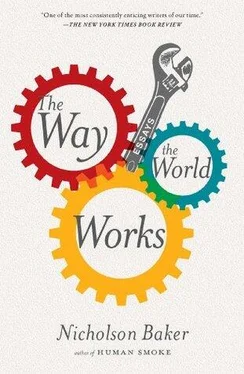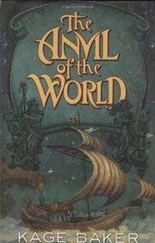Nicholson Baker - The Way the World Works
Здесь есть возможность читать онлайн «Nicholson Baker - The Way the World Works» весь текст электронной книги совершенно бесплатно (целиком полную версию без сокращений). В некоторых случаях можно слушать аудио, скачать через торрент в формате fb2 и присутствует краткое содержание. Год выпуска: 2012, Издательство: Simon & Schuster, Жанр: Публицистика, Критика, на английском языке. Описание произведения, (предисловие) а так же отзывы посетителей доступны на портале библиотеки ЛибКат.
- Название:The Way the World Works
- Автор:
- Издательство:Simon & Schuster
- Жанр:
- Год:2012
- ISBN:нет данных
- Рейтинг книги:4 / 5. Голосов: 1
-
Избранное:Добавить в избранное
- Отзывы:
-
Ваша оценка:
- 80
- 1
- 2
- 3
- 4
- 5
The Way the World Works: краткое содержание, описание и аннотация
Предлагаем к чтению аннотацию, описание, краткое содержание или предисловие (зависит от того, что написал сам автор книги «The Way the World Works»). Если вы не нашли необходимую информацию о книге — напишите в комментариях, мы постараемся отыскать её.
), here assembles his best short pieces from the last fifteen years.
The Way the World Works
OED
Modern Warfare 2
Through all these pieces, many written for
, and
, Baker shines the light of an inexpugnable curiosity.
is a keen-minded, generous-spirited compendium by a modern American master.
The Way the World Works — читать онлайн бесплатно полную книгу (весь текст) целиком
Ниже представлен текст книги, разбитый по страницам. Система сохранения места последней прочитанной страницы, позволяет с удобством читать онлайн бесплатно книгу «The Way the World Works», без необходимости каждый раз заново искать на чём Вы остановились. Поставьте закладку, и сможете в любой момент перейти на страницу, на которой закончили чтение.
Интервал:
Закладка:
In roman type, within quotation marks, this thought-quote could easily be Tolstoy; in italics, however, it is from Stephen King’s The Stand, page 516.
I suppose there’s no single correct method, but I sometimes wish that the old way would come back. I miss the clarity, the lack of fuss, the innocence. So here’s what I propose. Let’s use quotes for spoken dialogue, as usual, and — once in a while, if it makes sense, not excessively — let’s try using them for interior speech as well. Those who feel ambitious could experiment with double quotes for dialogue and single quotes for thought, since part of the problem is that double quotes sometimes look too heavy to fence off delicate interior states. But that distinction isn’t necessary and it may actually cause further confusion — so, no, skip that. If the words in the thought really do have force and punch, by all means use italics, but if they don’t, don’t. And if you would prefer to use only indirect thought-discourse, fine. Just don’t utterly rule out the blameless embrasure of those curlies. Here’s something I came across in Winnie-the-Pooh:
Sometimes he thought sadly to himself, “Why?” and sometimes he thought, “Wherefore?” and sometimes he thought, “Inasmuch as which?”—and sometimes he didn’t know what he was thinking about.
I’m with Eeyore.
(2002)
Defoe, Truthteller
I read Daniel Defoe’s A Journal of the Plague Year on a train from Boston to New York. That’s the truth. It’s not a very interesting truth, but it’s true. I could say that I read it sitting on a low green couch in the old smoking room of the Cincinnati Palladium, across from a rather glum-looking Henry Kissinger. Or that I found a beat-up Longman’s 1895 edition of Defoe’s Plague Year in a Dumpster near the Recycle-A-Bicycle shop on Pearl Street when I was high on Guinness and roxies, and I opened it and was drawn into its singular, fearful world, and I sat right down in my own vomit and read the book straight through. It would be easy for me to say these things. But if I did, I would be inventing — and, as John Hersey wrote, the sacred rule for the journalist (or the memoirist, or indeed for any nonfiction writer) is: Never Invent. That’s what makes Daniel Defoe, the founder of English journalism, such a thorny shrub. The hoaxers and the embellishers, the fake autobiographers, look on Defoe as a kind of patron saint. Defoe lied a lot. But he also hated his lying habit, at least sometimes. He said the lying made a hole in the heart. About certain events he wanted truth told. And one event he really cared about was the great plague of 1665, which happened when he was around five years old.
A Journal of the Plague Year begins quietly, without any apparatus of learnedness. It doesn’t try to connect this recent plague with past plagues. It draws no historical or classical or literary parallels. It just begins: “It was about the beginning of September, 1664, that I, among the rest of my neighbors, heard in ordinary discourse that the plague was returned again in Holland.” The “I” is not Defoe, but an older proxy, somebody mysteriously named H.F., who says he is a saddler. H.F. lives halfway between Aldgate Church and Whitechapel, “on the left hand or north side of the street.” That’s all we know about him.
H.F. watches the bills of mortality mount — he keeps track — and he debates with himself whether to stay in town or flee. His brother tells him to save himself, get away. But no, H.F. decides to stay. He listens. He walks around. He sees a man race out of an alley, apparently singing and making clownish gestures, pursued by women and children — surgeons had been at work on his plague sores. “By laying strong caustics on them, the surgeons had, it seems, hopes to break them, which caustics were then upon him, burning his flesh as with a hot iron.” H.F. hears screams — many different kinds of screams, and screeches, and shrieks. In an empty street in Lothbury, a window opens suddenly just over his head. “A woman gave three frightful screeches, and then cried, ‘Oh! death, death, death!’” There was no other movement. The street was still. “For people had no curiosity now in any case.”
At the plague’s height, H.F. writes, there were no funerals, no wearing of black, no bells tolled, no coffins. “Whole streets seemed to be desolated,” he says, “doors were left open, windows stood shattering with the wind in empty houses, for want of people to shut them; in a word, people began to give up themselves to their fears, and to think that all regulations and methods were in vain, and that there was nothing to be hoped for but an universal desolation.”
What do we know about Defoe? Very little. He was one of the most prolific men ever to lift a pen, but he wrote almost nothing about himself. Not many letters have survived. Readers have been attributing and de-attributing Defoe’s anonymous journalism ever since he died, broke, in Ropemaker’s Alley, in 1731. He was almost always writing about someone else — or pretending to be someone else. There are a few engravings of him, and only one surviving prose description. It’s unfriendly — in fact it was a sort of warrant for his arrest, printed in a newspaper when Defoe was wanted by the government on a charge of seditious libel. “He is a middle-sized, spare man,” said the description, “about forty years old, of a brown complexion, and dark brown-colored hair, but wears a wig; a hooked nose, a sharp chin, grey eyes, and a large mole near his mouth.” Anyone who could furnish information leading to his apprehension by her majesty’s justices of the peace, said the notice, would receive a reward of fifty pounds.
We know that Defoe, late in life, wrote the first English novels— Robinson Crusoe in 1719, about a lonely sailor who sees a man’s naked footprint on the beach, and Moll Flanders in January 1722, about a woman who was “twelve year a whore.” We know that he was born about 1660, the son of a London butcher or candlemaker named James Foe. In his twenties, Daniel went into business as a hosier — that is, as a seller of women’s stockings. Trade and speculation went well for a while, then less well, and then he had to hide from his creditors, to whom he owed seventeen thousand pounds. He was rescued by friends on high, and began writing pamphlets and poetry. Soon he was running a large company that made roofing tiles — and the pamphleteering was surprisingly successful. He added a Frenchifying “de” to his name. In 1701 he produced the most-selling poem up to that time, “The True-Born Englishman,” which hymned his native land as a motley nation of immigrants: “Thus, from a mixture of all kinds began / That het’rogenous thing, an Englishman.” Another pamphlet — in which, several decades before Swift’s “Modest Proposal,” he pretended to be a rabid high-churchman who advocated the deportation or hanging of nonconformists — got him clamped in a pillory in 1703 and sent to Newgate Prison.
While in prison he started a newspaper, the Review, an antecedent to Addison and Steele’s Tatler and Spectator . Besides essays and opinion pieces, the Review had an early advice column, and a “weekly history of Nonsense, Impertinence, Vice, and Debauchery.” That same year, still in prison, he gathered intelligence on a disaster that had visited parts of England. His book The Storm —about what he called “the greatest and the longest storm that ever the world saw”—is one of the earliest extended journalistic narratives in English.
For a faker, Defoe had an enormous appetite for truth and life and bloody specificity. He wanted to know everything knowable about trade, about royalty, about low life, about the customs of other countries, about ships, about folk remedies and quack doctors, about disasters, about scientific advances, and about the shops and streets of London. He listened to stories people told him. “In this way of Talk I was always upon the Inquiry,” one of his characters says, “asking questions of things done in Publick, as well as in Private.” But his desire to impersonate and playact kept surging up and getting him into trouble. He wanted to pass as someone he wasn’t — as a Swedish king, as a fallen woman, as a person who’d seen a ghost, as a pre-Dickensian pickpocket. He was an especially industrious first-person crime writer. Once he ghost-wrote the story of a thief and jailbreaker named Jack Sheppard. To promote its publication, Defoe had Sheppard pause at the gallows and, before a huge crowd, hand out the freshly printed pamphlet as his last testament — or so the story goes. “The rapidity with which this book sold is probably unparalleled,” writes an early biographer, William Lee.
Читать дальшеИнтервал:
Закладка:
Похожие книги на «The Way the World Works»
Представляем Вашему вниманию похожие книги на «The Way the World Works» списком для выбора. Мы отобрали схожую по названию и смыслу литературу в надежде предоставить читателям больше вариантов отыскать новые, интересные, ещё непрочитанные произведения.
Обсуждение, отзывы о книге «The Way the World Works» и просто собственные мнения читателей. Оставьте ваши комментарии, напишите, что Вы думаете о произведении, его смысле или главных героях. Укажите что конкретно понравилось, а что нет, и почему Вы так считаете.












